Section 1: Agency overview and resources
1.1 Strategic direction
The role of the Australian Taxation Office (ATO) is to achieve confidence in the administration of Australia's taxation and superannuation systems.
The taxation and superannuation systems are part of Australia's social and economic infrastructure. A major part of the ATO's administration of these systems is emphasising to the community the importance of willing and proper participation, in underpinning nation building.
The ATO's Strategic Statement 2010-15 strengthens this view by outlining a strategic vision for the taxation and superannuation systems. The vision aspires for Australians to value their taxation and superannuation systems as community assets, where willing participation is recognised as good citizenship.
The journey towards achievement of the Strategic Statement is guided by five strategic themes that intersect all levels in the ATO's vision and daily activities. The strategic themes are:
- Encourage: People support and understand the benefits of participation — they are engaged and willingly participate;
- Support: People are helped and assisted to understand their rights and responsibilities and are able to fulfil their obligations easily at minimal cost;
- Protect: Protecting people and the community by deterring, detecting and dealing with those who have not complied;
- Enhance: The ATO is passionate about improving its capabilities to be more innovative, agile and responsive to challenges and opportunities; and
- Champion: The ATO champions interests of both individual taxpayers and the community, advising government on ways to improve the operation of Australia's taxation and superannuation systems.
These themes are supported by the ATO's corporate values of being fair and professional, applying the rule of law, supporting people who want to do the right thing and being fair but firm with those that don't, being consultative, collaborative and willing to co-design, being open and accountable and being responsive to challenges and opportunities.
Having just successfully implemented one of the most significant IT change programs in its history, the ATO is looking to optimise its new platforms by re-engineering business processes to encourage and support the community to willingly participate in Australia's taxation and superannuation systems.
There will need to be sustained focus in helping those recovering as a result of natural disasters. The ATO's help and assistance program of work will support this cause while remaining vigilant against those who seek an unfair advantage.
1.2 Agency resource statement
Table 1.1 shows the total resources from all sources. The table summarises how resources will be applied by outcome and by administered and departmental classification.
Table 1.1: Australian Taxation Office resource statement — Budget
estimates for 2011-12 as at Budget May 2011
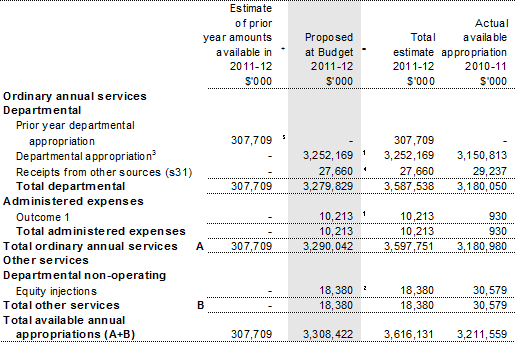
Table 1.1: Australian Taxation Office resource statement — Budget
estimates for 2011-12 as at Budget May 2011 (continued)

1. Appropriation Bill (No. 1) 2011-12.
2. Appropriation Bill (No. 2) 2011-12.
3. Includes $137.8 million in 2011-12 ($137.3 million in 2010-11) for the Departmental Capital Budget (refer to Table 3.2.5 for further details).
4. Receipts received under s31 of the Financial Management and Accountability Act 1997.
5. Estimated adjusted balance carried from previous year for annual appropriations.
6. Estimated opening balance for special accounts (refer to Table 3.1.2 for further details).
7. These figures relate to administered expenses including fuel tax credits, superannuation co-contributions, education tax refunds and research and development subsidies. Estimated tax refund items for 2010-11 are $88.2 billion (including $75 million paid via the Australian Customs Service (ACS) on the ATO's behalf) and $93.0 billion for 2011-12 (including $80 million paid via the ACS on the ATO's behalf).
1.3 Budget measures
Budget measures relating to the ATO are detailed in Budget Paper No. 2, Budget Measures 2011-12 and are summarised below.
Table 1.2: Australian Taxation Office 2011-12 Budget measures
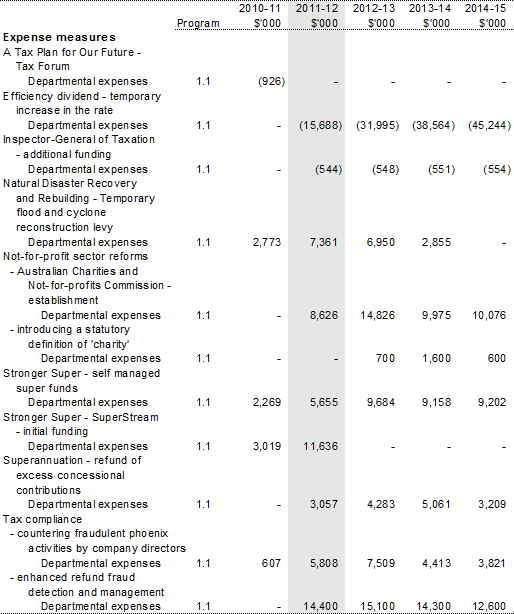
Table 1.2: Australian Taxation Office 2011-12 Budget measures (continued)
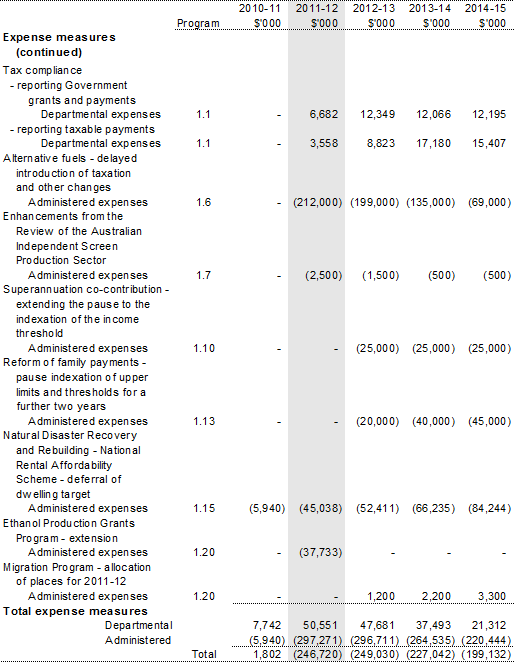
Table 1.2: Australian Taxation Office 2011-12 Budget measures (continued)
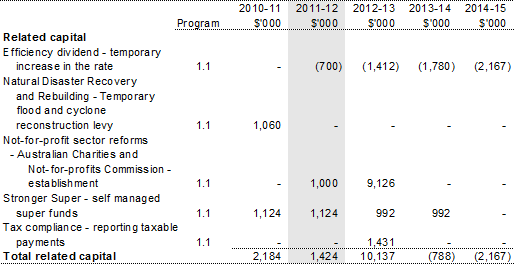
Prepared on a government finance statistics (fiscal) basis.
1.4 Changes to the program structure
The ATO has revised its program structure since the 2010-11 Budget. The Australian Business Register (ABR) and the Australian Valuation Office (AVO) (previously part of Program 1.1) are now separate programs 1.3 and 1.4 respectively.
As a result of this there have also been some minor changes to other program numbers, which are shown as part of Table 2.1.
Section 2: Outcomes and planned performance
2.1 Outcomes and performance information
Government outcomes are the intended results, impacts or consequences of actions by the Government on the Australian community. Commonwealth programs are the primary vehicle by which government agencies achieve the intended results of their outcome statements. Agencies are required to identify the programs which contribute to Government outcomes over the budget and forward years.
The ATO's outcome is described below specifying the strategy, programs, objectives, deliverables and key performance indicators used to assess and monitor the performance of ATO.
Outcome 1: Confidence in the administration of aspects of Australia's taxation and superannuation systems through helping people understand their rights and obligations, improving ease of compliance and access to benefits, and managing non-compliance with the law
Outcome 1 strategy
The ATO seeks to deliver this outcome by:
- encouraging community participation in Australia's taxation and superannuation systems;
- supporting people willing to participate and making it as easy as possible for them to fulfil their responsibilities at minimum cost; and
- protecting people by dealing with those not willing to comply.
The ATO does this both as a single agency, as well as through managing a number of whole-of-government initiatives that deliver a range of services. The ATO also provides support to the Tax Practitioners Board, the ABR and the AVO.
The ATO has five broad indicators of effectiveness. These help to measure performance and how effective the agency is in delivering a high level of service to the government and the community. They are:
- Deliver aspects of taxation and superannuation systems for government and the community.
- Maintain community confidence and engagement.
- Help people understand their rights and obligations.
- Improve ease of compliance and access to ben
efits. - Manage non-compliance with the law.
The ATO publishes a range of governance publications including the Strategic Statement, Corporate Plan and Compliance Program which outline the ATO's strategic direction and annual commitments to the community. The ATO's Annual Report assesses the achievements of the agency against these commitments.
The ATO also administers a range of subsidies and benefits, including fuel tax credits, research and development tax offsets, and superannuation incentives. These initiatives or schemes involve eligibility rules and conditions set out in legislation. Several of these administered programs deliver other government agencies' outcomes, with the ATO acting as a service delivery agency.
While the benefits delivered through these administered programs are funded through special appropriations the cost of the work and systems required to deliver the benefits is included in the ATO's departmental funding under Program 1 and is not specifically or separately identified.
Outcome expenses statement
Table 2.1 provides an overview of the total expenses for Outcome 1.
Table 2.1: Budgeted expenses for Outcome 1
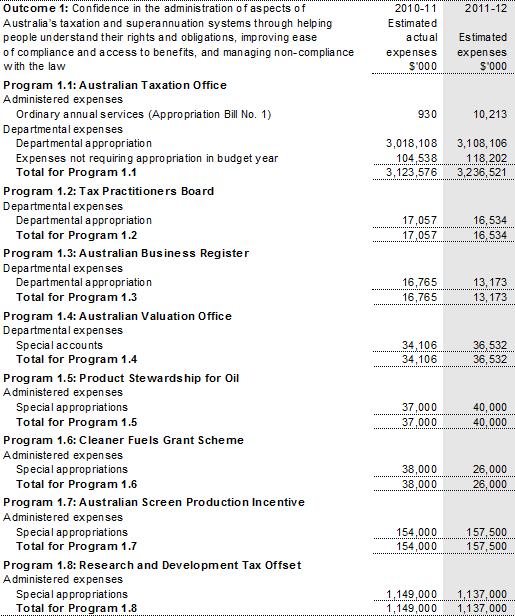
Table 2.1: Budgeted expenses and resources for Outcome 1 (continued)
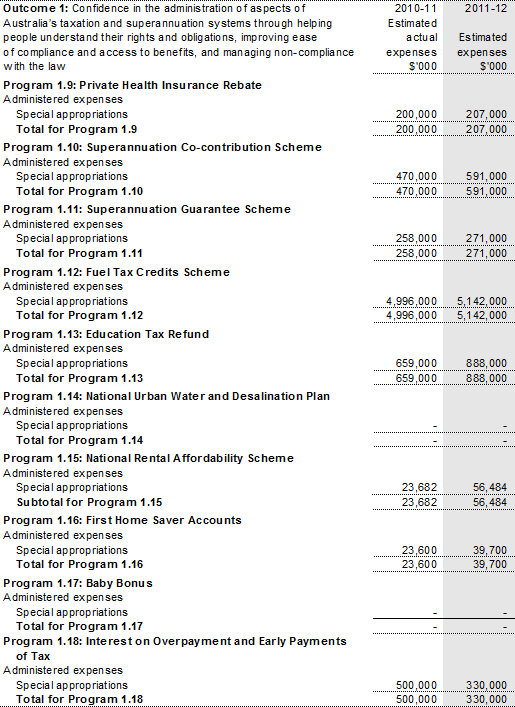
Table 2.1: Budgeted expenses and resources for Outcome 1 (continued)
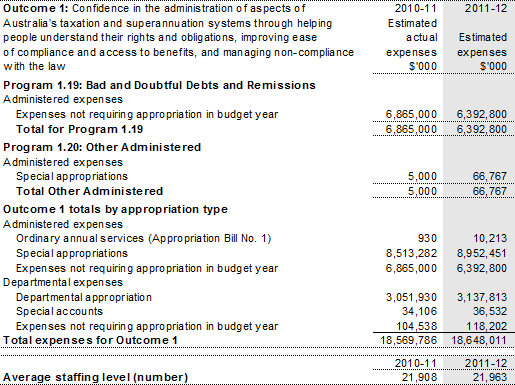
Contributions to Outcome 1
Program 1.1: Australian Taxation Office
Program 1.1 objective
The ATO is the Government's principal revenue collection agency, administering Australia's taxation system, regulating aspects of the superannuation system, and supporting delivery of government benefits to the community.
The objective of the ATO is to administer aspects of Australia's taxation and superannuation systems fairly by helping people do the right thing, by making it as easy as possible for taxpayers to comply, ensuring effective strategies are in place to deter, detect and deal with non-compliance, and developing and supporting the capability of its people and of others in the system.
Program 1.1 expenses
Estimates for the forward years reflect the impact of government policy initiatives.
Table 2.2: Program 1.1 expenses by program component
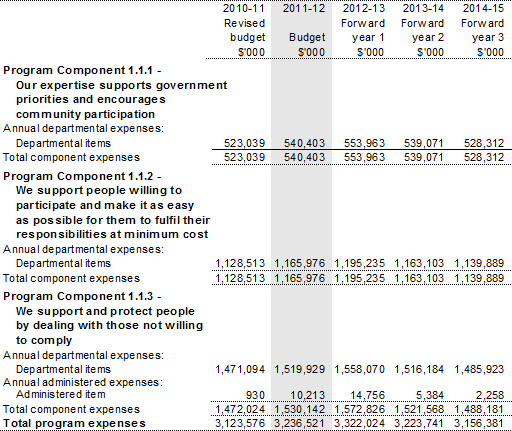
Program 1.1 deliverables
Program Component 1.1.1: Our expertise supports government priorities and encourages community participation
- Advise government on policy, forecasting and administrative matters.
- Design and build administrative solutions for new policy, law and other initiatives.
- Clarify the law and provide clear advice as to the ATO's view of the law.
- Support other agencies.
- Manage Government and stakeholder relations.
Program Component 1.1.2: We support people willing to participate and make it as easy as possible for them to fulfil their responsibilities at minimum cost
- Register taxpayers.
- Process returns and check accuracy.
- Receive payments, facilitate timely payments, and follow up overdue payments.
- Provide guidance to taxpayers on how to meet obligations.
- Collect and manage debt.
Program Component 1.1.3: We support and protect people by dealing with those not willing to comply
- Communicate and market products, services and benefits to the community.
- Provide interpretative advice and practical guidance.
- Identify and respond to behaviours presenting a compliance risk.
- Undertake preventative actions to reduce the rate of occurrence of non-compliant behaviour.
Program 1.1 key performance indicators
Program Component 1.1.1: Our expertise supports government priorities and encourages community participation
- Progress new administrative solutions to support taxation and superannuation administration.
- Reduce legal risks and increase certainty through ATO views.
- Manage the ATO's commitments to governments and other agencies.
Program Component 1.1.2: We support people willing to participate and make it as easy as possible for them to fulfil their responsibilities at minimum cost
- Progress new services that support service delivery.
- Maintain acceptable service standards.
- Maintain quality and practical means of assistance.
- Optimise debt collection for the current environment.
Program Component 1.1.3: We support and protect people by dealing with those not willing to comply
- Products, services and tools are available to help people meet their obligations.
- Issue advice and practical guidance that assists people to meet their obligations.
- Reduce non-compliant behaviours through deterring, detecting and dealing with taxpayers not willing to comply.
- Establish the nature and extent of non-compliant behaviour and, where appropriate, apply penalties and prosecute.
Program 1.2: Tax Practitioners Board
Program 1.2 objective
The objective of the Tax Practitioners Board is to strengthen the integrity of the taxation system and tax profession by including all tax practitioners in a single national regulatory regime and regulating them fairly, consistently and with flexibility.
The Tax Practitioners Board provides protection to clients of tax practitioner services by reducing the level of uncertainty and risks for people through a new, national, independent regulatory regime for tax agent services.
Program 1.2 expenses
Estimates for the forward years reflect the impact of government policy initiatives.
Table 2.3: Program 1.2 expenses

1. Does not include corporate overhead costs.
Program 1.2 deliverables
- Register tax practitioners.
- Ensure that records are current and accurate.
- Cancel the registrations of tax practitioners that are no longer active or entitled to be registered.
- Administer the Code of Professional Conduct that clearly provides high standards and expectations for professionals providing tax agent services.
- Apply consistent sanctions for those who do not comply with the law, including civil penalties and injunctions and other sanctions.
- Fairly investigate referrals from the ATO and community.
- Provide the community with access to public data to assist in verifying registered tax practitioners.
- Manage and promote the role and functions of the Board.
Program 1.2 key performance indicators
- Establish and broaden the regulatory framework across tax practitioners.
- Maintain acceptable service standards.
- Work cooperatively with tax practitioners.
- Reduce risks for consumers in using tax practitioners.
- Increase awareness and engagement amongst tax practitioners.
Program 1.3: Australian Business Register
The Commissioner of Taxation is also the Registrar of the Australian Business Registration (ABR). The two roles have separate and distinct responsibilities as outlined in section 28 of the A New Tax System (Australian Business Number)
Act 1999.
Reporting and governance arrangements have been enhanced to provide clearer delineation between the performance of the Registrar and the Commissioner of Taxation, who is a customer of the ABR.
This new program complements the ATO's fundamental role in administering aspects of Australia's taxation and superannuation systems.
Program 1.3 objective
The ABR provides an authoritative and trusted source of business identity information and issues the Australian Business Number (ABN) to uniquely identify businesses and streamline government and business interaction.
The objective of the program is to progress the ABR as a whole-of-government resource for streamlining business and government interactions. The ABN acts as the unique identifier enabling these interactions.
Program 1.3 expenses
Estimates for the forward years reflect the impact of government policy initiatives.
Table 2.4: Program 1.3 expenses

Program 1.3 deliverables
- Issue and maintain the ABN and AUSkey registrations to support interactions between government and businesses.
- Promote the ABR, AUSkey and SBR as whole-of-government resources. Provide eligible government agencies with access to details of registered ABN holders.
- Provide the community with access to publicly available data to assist in verifying core business identity and other government registration information.
Program 1.3 key performance indicators
- Progress new services that support whole-of-government projects.
- Increase agency awareness and engagement.
- Improve integrity of the ABR data.
- Maintain acceptable service standards.
Program 1.4: Australian Valuation Office
The AVO is set up as a special account and is the only commercially-focussed business area within the ATO. As a separate program it will now be visible within the outcome and program framework.
The AVO provides a service for all Commonwealth agencies and complements the ATO's fundamental role in administering aspects of Australia's taxation system and superannuation system.
Program 1.4 objective
The AVO aims to provide independent, impartial and fee-competitive valuation services and advice on behalf of the Australian Government.
The objective of the AVO is to be recognised as the valuer of choice for government. This requires it to focus both on the needs of clients and on the capability of its people to collectively build a resilient, viable and sustainable business into the future.
Program 1.4 expenses
The estimates show moderate growth across the forward years based on revenue projections.
Table 2.5: Program 1.4 expenses

Program 1.4 deliverables
- Valuation services.
- Policy and strategic advice on valuation issues.
Program 1.4 key performance indicators
- Progress new services that support delivery of valuation services and policy advice.
- Maintain acceptable service standards.
- Strengthen relationships and satisfaction with key clients.
- Maintain appropriate governance and reporting processes.
- Maintain an appropriate level of quality of valuation services.
Program 1.5: Product Stewardship for Oil
Program 1.5 objective
The Product Stewardship for Oil program is aimed at supporting and encouraging environmentally sustainable management of used oil including the recycling of used oil and use of the recycled product. The program is intended to reinforce existing state and territory regulations and arrangements in this area.
The Department of Sustainability, Environment, Water, Population and Communities (SEWPaC) has policy responsibility for the program, with the ATO administering the program on its behalf.
Program 1.5 expenses
The estimates show moderate growth across the forward years.
Table 2.6: Program 1.5 expenses

Program 1.5 deliverables
The ATO is responsible for delivery of products and services, by undertaking all processes, decisions and actions required to administer the program. The ATO provides compliance assurance and support to SEWPaC. Successful delivery is demonstrated by:
- the number of claims processed;
- the number of participants registered;
- the dollar value of payments processed; and
- the dollar value of revenue collected.
Program 1.5 key performance indicators
The ATO's role in successfully delivering this program is demonstrated by payments being made in accordance with the law.
Program 1.6: Cleaner Fuels Grant Scheme
Program 1.6 objective
The Cleaner Fuels Grant Scheme encourages the manufacture or importation of fuels that have a reduced impact on the environment. Manufacturers and importers of cleaner fuels that meet the relevant fuel standard under the Fuel Quality Standards Act 2000 may be entitled to a cleaner fuel grant.
The Department of the Treasury (the Treasury) has policy responsibility for the program, with the ATO administering the program on its behalf.
Program 1.6 expenses
These estimates are impacted by Budget measures. Refer to Table 1.2 and Budget Paper No. 2, Budget Measures 2011-12 for further information. The new tax arrangements for the alternative fuels will not involve payment of a grant from 1 December 2011
Table 2.7: Program 1.6 expenses

Program 1.6 deliverables
The ATO is responsible for delivery of products and services by undertaking all processes, decisions and actions required to administer the program. The ATO provides compliance assurance and support to the Treasury and SEWPaC. Successful delivery is demonstrated by:
- the number of claims processed;
- the number of participants registered; and
- the dollar value of payments processed.
Program 1.6 key performance indicators
The ATO's role in successfully delivering this program is demonstrated by payments being made in accordance with the law.
Program 1.7: Australian Screen Production Incentive
Program 1.7 objective
The Australian Screen Production Incentive comprises three film tax offsets: the Producer Offset, the Location Offset and the Post, Digital and Visual Effects (PDV) Offset. These offsets are designed to ensure Australia remains competitive in attracting high budget film and television productions and are aimed at providing increased opportunities for Australian casts, crew, post-production companies and other services to participate in these productions.
The Department of the Prime Minister and Cabinet (PM&C), along with Screen Australia and the ATO, have policy responsibility for the program. Screen Australia administers the Producer Offset while PM&C has administrative responsibility for the Location and PDV Offsets.
Program 1.7 expenses
These estimates are impacted by Budget measures. Refer to Table 1.2 and Budget Paper No. 2, Budget Measures 2011-12 for further information.
Table 2.8: Program 1.7 expenses

Program 1.7 deliverables
The ATO is responsible for administering the processing of claims, following
certification, through the income tax return lodgment process and under co-administration arrangements with PM&C and Screen Australia. The ATO also provides a degree of compliance assurance and support for the claims process. Successful delivery is demonstrated by:
- the dollar value of tax offsets processed; and
- the number of tax offsets processed.
Program 1.7 key performance indicators
The ATO's role in successfully delivering this program is demonstrated by payments being made in accordance with the law.
Program 1.8: Research and Development Tax Offset
Program 1.8 objective
The Research and Development (R&D) Tax Offset is an ongoing scheme designed to increase the level of research and development being conducted by Australian companies.
The Department of Innovation, Industry, Science and Resources (DIISR) has key policy responsibility for the program, whilst administration of the offset is split between the ATO and AusIndustry, the operating arm of DIISR.
AusIndustry is responsible for processing registrations for companies intending to claim the concession, determining eligible activities, determining whether the research and development is exploited for the benefit of the Australian economy, processing applications for overseas activities and making determinations as to whether technology constitutes core technology.
Program 1.8 expenses
The estimates show moderate growth across the forward years.
Table 2.9: Program 1.8 expenses

Program 1.8 deliverables
The ATO is responsible for administering the concession through the income tax return lodgment process and providing compliance assurance and support for the process. The ATO has responsibility for the expenditure aspects of the concession and also provides marketing and education support for companies and their agents. Successful delivery is demonstrated by:
- the number and dollar value of claims processed for Australian owned R&D general concession claimants;
- the number of incremental concession claims made by general concession claimants;
- the number of claims processed for R&D tax offsets;
- the percentage of R&D tax offset claims processed in accordance with service standards;
- the number and dollar value of claims processed for foreign-owned R&D (100 per cent deduction); and
- the number and dollar value of claims processed for 175 per cent international premium concessions.
Program 1.8 key performance indicators
The ATO's role in successfully delivering this program is demonstrated by payments being made in accordance with the law.
Program 1.9: Private Health Insurance Rebate
Program 1.9 objective
The Australian Government introduced the Private Health Insurance Rebate as an incentive to take up private health insurance.
The Department of Health and Ageing has policy responsibility for the program, whilst administration of the program is split between the ATO, Medicare Australia and registered health insurers, depending on the claim method.
Program 1.9 expenses
There are no significant changes to estimates across the forward years.
Table 2.10: Program 1.9 expenses

Program 1.9 deliverables
The ATO is responsible for administering the rebate through the income tax return lodgment process and providing compliance assurance and support for the process. The ATO also provides marketing and education support for individuals and their agents. Successful delivery is demonstrated by:
- the number of claims processed; and
- the dollar value of rebates processed.
Program 1.9 key performance indicators
The ATO's role in successfully delivering this program is demonstrated by payments being made in accordance with the law.
Program 1.10: Superannuation Co-contribution Scheme
Program 1.10 objective
The Superannuation Co-contribution Scheme is an Australian Government initiative to help low to middle income earners save for their retirement. Eligible individuals that make personal superannuation contributions to a complying superannuation fund or retirement savings account receive a co-contribution from the Government up to certain limits.
The Department of the Treasury has policy responsibility for the program, while the ATO administers the program and provides information and support to individuals and superannuation funds through marketing and education services.
Program 1.10 expenses
These estimates are impacted by Budget measures. Refer to Table 1.2 and Budget Paper No. 2, Budget Measures 2011-12 for further information.
Table 2.11: Program 1.10 expenses

Program 1.10 deliverables
The ATO is responsible for determining eligibility, calculating the amount of entitlement to be paid and making the payment, and notifying individuals of their entitlement. Successful delivery is demonstrated by:
- the number of individuals eligible for co-contributions;
- the value of co-contributions distributed; and
- the percentage of co-contribution claims paid to superannuation funds within service standards.
Program 1.10 key performance indicators
The ATO's role in successfully delivering this program is demonstrated by payments being made in accordance with the law.
Program 1.11: Superannuation Guarantee Scheme
Program 1.11 objective
Under the Superannuation Guarantee (Administration) Act 1992, most employers must pay superannuation contributions (in addition to gross salary and wages paid) into a complying superannuation fund or retirement savings account so that their eligible employees can enjoy the benefits of superannuation in their retirement.
Program 1.11 expenses
There are no significant changes to estimates across the forward years.
Table 2.12 Program 1.11 expenses

Program 1.11 deliverables
To ensure that employers meet their obligations, the ATO checks employer records, investigates employee complaints and referrals in relation to choice of fund and superannuation guarantee contributions. Successful delivery is demonstrated by:
- the number of superannuation guarantee complaints leading to employer record checks;
- the number of employees whose superannuation funds have not received the superannuation to which the employees are entitled;
- the number of employers whose records are checked;
- the dollar value of superannuation guarantee charge raised;
- the dollar value of superannuation guarantee charge collected;
- the dollar value of penalties and interest;
- the percentage of superannuation complaints resolved in accordance with service standards; and
- the percentage of superannuation guarantee cases completed in accordance with service standards.
Program 1.11 key performance indicators
The ATO's role in successfully delivering this program is demonstrated by payments being made in accordance with the law.
Program 1.12: Fuel Tax Credits Scheme
Program 1.12 objective
The Fuel Tax Credits Scheme provides fuel tax relief in the form of fuel tax credits for fuel tax embedded in the price of the fuel, such as excise or customs duty, for fuel used in business activities,
machinery, plant, equipment and heavy vehicles.
Under the Fuel Tax Credits Scheme, all fuels including petrol, acquired, manufactured or imported into Australia for business use or the generation of electricity for domestic use will become excise tax-free over time, with some exceptions.
Program 1.12 expenses
The expenses are impacted by the expansion to the Fuel Tax Credits Scheme commencing in July 2012.
Table 2.13: Program 1.12 expenses

Program 1.12 deliverables
The ATO is responsible for administering the fuel tax credits scheme and providing compliance assurance and support. Successful delivery is demonstrated by:
- the dollar value of claims; and
- the number of registered participants.
Program 1.12 key performance indicators
The ATO's role in successfully delivering this program is demonstrated by payments being made in accordance with the law.
Program 1.13: Education Tax Refund
Program 1.13 objective
The Education Tax Refund (ETR) is an initiative to help with the cost of educating primary and secondary school children. It means eligible parents, carers, legal guardians and independent students could get 50 per cent back on some education expenses such as computers, educational software, textbooks and stationery.
The Department of Education, Employment and Workplace Relations has policy responsibility for the program, while the ATO administers the program on its behalf.
Program 1.13 expenses
The estimate in 2010-11 reflects adjustments for the over estimation of the first two years of the program. The estimates are expected to increase from 2011-12 onwards as a result of the extension of ETR claimable items to include school uniforms.
Table 2.14: Program 1.13 expenses

Program 1.13 deliverables
The ATO is responsible for administering the rebate through the income tax return lodgment process and providing compliance assurance and support for the process. Successful delivery is demonstrated by:
- the dollar value of tax offsets processed; and
- the number of tax offsets processed.
Program 1.13 key performance indicators
The ATO's role in successfully delivering this program is demonstrated by payments being made in accordance with the law.
Program 1.14: National Urban Water and Desalination Plan
Program 1.14 objective
The National Urban Water and Desalination Plan aims to support desalination, water recycling and stormwater harvesting projects in Australian cities.
The private sector, water utilities and state, territory and local governments will be able to apply for funds, which will be provided through grants and refundable tax offsets.
SEWPaC has responsibility for the program, including the payment of grants.
Program 1.14 expenses
ATO expenses have been transferred to SEWPaC. Where tax offset certificates are to be issued to private sector projects in the future, the required funds will be transferred from SEWPaC to the ATO.
Table 2.15: Program 1.14 expenses

Program 1.14 deliverables
The ATO is responsible for administering the tax offset and providing compliance assurance and support for the process. Successful delivery is demonstrated by:
- the number of certificates lodged with the ATO by SEWPaC.
Program 1.14 key performance indicators
The ATO's role in successfully delivering this program is demonstrated by payments being made in accordance with the law.
Program 1.15: National Rental Affordability Scheme
Program 1.15 objective
The National Rental Affordability Scheme aims to provide affordable rental properties across Australia for low and middle income earners. An annual incentive will be paid by refundable tax offsets for complying institutional investors and by grants for not-for-profit housing organisations that are exempt from income tax.
The Department of Families, Housing, Community Services and Indigenous Affairs (FaHCSIA) has policy responsibility for the program, which aims to see the building of new affordable rental properties by managing a competitive process for allocation of the incentive and monitoring compliance and eligibility.
Program 1.15 expenses
These estimates are impacted by Budget measures. Refer to Table 1.2 and Budget Paper No. 2, Budget Measures 2011-12 for further information
Table 2.16: Program 1.15 expenses

Program 1.15 deliverables
The ATO is responsible for administering the tax offset through the income tax return lodgment process and providing compliance assurance and support for the process. Successful delivery is demonstrated by:
- the dollar value of tax offsets processed;
- the number of tax offsets processed; and
- the ratio of claims made through the ATO to direct claims made through FaHCSIA.
Program 1.15 key performance indicators
The ATO's role in successfully delivering this program is demonstrated by payments being made in accordance with the law.
Program 1.16: First Home Saver Accounts
Program 1.16 objective
First Home Saver Accounts assist first home buyers to save a larger deposit through a combination of lower taxes and a government contribution. These accounts are offered by eligible financial institutions.
The Department of the Treasury has policy responsibility for the program which aims to increase the proportion of homes being bought by first buyers by helping them save a deposit and supporting national savings levels. Administration is split between the ATO, the Australian Prudential Regulation Authority and the Australian Securities and Investments Commission.
Program 1.16 expenses
Growth in the estimates across the forward years reflects an expected increase in entrants to the program.
Table 2.17: Program 1.16 expenses

Program 1.16 deliverables
The ATO is responsible for the calculation and payment of the government contribution and compliance of first home saver account holders and providers. Successful delivery is demonstrated by:
- the dollar value of government contributions paid;
- the number of first home saver accounts;
- the dollar value of account balances; and
- the percentage of government contributions paid to account holders in accordance with service standards.
Program 1.16 key performance indicators
The ATO's role in successfully delivering this program is demonstrated by payments being made in accordance with the law.
Program 1.17: Baby Bonus
Program 1.17 objective
The primary intent of the Baby Bonus tax offset is to provide compensation, in the form of a refundable tax offset, for the economic loss experienced in leaving the workforce to care for a new child and to provide a basic benefit for low income earners caring for a new child.
Program 1.17 expenses
This program ceased on 30 June 2009. There will be no further expenses as all expenses have been recognised in prior years. However, payments will be made to claimants who lodge late claims. Claimants have until 30 June 2014 to lodge baby bonus claims with the
ATO.
Table 2.18: Program 1.17 expenses

Program 1.17 deliverables
Successful delivery is demonstrated by:
- the dollar value of payments processed; and
- the number of eligible individuals receiving payments.
Program 1.17 key performance indicators
The ATO's role in successfully delivering this program is demonstrated by payments being made in accordance with the law.
Program 1.18: Interest on Overpayments and Early Payments of Tax
Program 1.18 objective
Various laws provide for credit interest to be paid to taxpayers in certain circumstances on certain refunded amounts where the amounts are not refunded within a specified time.
There are three general categories under the Taxation (Interest on Overpayments and Early Payments) Act 1983 which create credit interest entitlements for taxpayers in certain circumstances:
- interest on early payments of tax;
- interest on overpayments of tax; and
- delayed refund interest.
Program 1.18 expenses
There are no significant changes to estimates across the forward years.
Table 2.19: Program 1.18 expenses

Program 1.18 deliverables
The ATO administers eligibility and payments under the Taxation (Interest on Overpayments and Early Payments) Act 1983. Successful delivery is demonstrated by:
- the dollar value of interest paid.
Program 1.18 key performance indicators
The ATO's role in successfully delivering this program is demonstrated by interest entitlements being made in accordance with the law.
Program 1.19: Bad and Doubtful Debts and Remissions
Program 1.19 objective
Taxpayers are expected to pay their taxation debts as and when they fall due for payment. Where tax debts are not paid by the due date, the ATO has the responsibility of collecting the outstanding amount.
This program deals with both the tax debt and the additional charges for late payment (such as general interest charge) automatically imposed by legislation, that is unlikely to be recovered.
While the program is primarily concerned with assisting taxpayers to meet their payment and lodgment obligations, the provision for bad and doubtful debts and discretion allowed for remission of additional charges for late payment is an expense to the Australian Government.
Program 1.19 expenses
The estimates show moderate growth across the forward years.
Table 2.20: Program 1.19 expenses

Program 1.19 deliverables
The ATO administers Bad and Doubtful Debts and Remissions based on legislation and ATO policy. Successful delivery is demonstrated by:
- the dollar value of provisions; and
- the dollar value of remissions.
Program 1.19 key performance indicators
The ATO's role in successfully delivering this program is demonstrated by determining bad and doubtful debts and remissions in accordance with ATO policy and legislation.
Program 1.20: Other Administered
Program 1.20 objective
Other Administered includes the Tax Bonus, Domestic Ethanol Assistance and Low Income Earner Contribution.
The Tax Bonus is part of the Australian Government's Nation Building Economic Stimulus Plan, which provides for targeted bonus payments to assist households and support economic growth. The Tax Bonus payment commenced from April 2009 and will continue until all eligible people have been paid.
The Domestic Ethanol Assistance scheme is to introduce an energy content-based fuel excise system in order to give the Australian ethanol industry adequate time to prepare for forthcoming changes. The amended arrangement will ensure that there is no sudden loss of the tax differential between domestic and imported ethanol.
The Low Income Earner Contribution is to provide a superannuation contributions tax rebate of up to $500 annually for low income earners, with effect from the 2012-13 income year. This rebate will improve the fairness of superannuation taxation arrangements by effectively rebating most of the tax payable on concessional superannuation contributions made by or for low-income earners.
Program 1.20 expenses
The Tax Bonus is a one-off payment. The program ceased in 2009-10 but payments will continue until all eligible people have been paid.
The estimate for Domestic Ethanol Assistance in 2011-12 has been reduced due to a transfer of budget to the Department of Resources, Energy and Tourism as the ATO will not commence administering this scheme until December 2011. After 2012-13 the estimates decrease over the forward years as the rate of the offsetting assistance payment to domestic ethanol producers is progressively reduced.
The estimates for the Low Income Earner Contribution are impacted by Budget measures. Refer to Table 1.2 and Budget Paper No. 2, Budget Measures 2011-12 for further information.
Table 2.20: Program 1.20 expenses
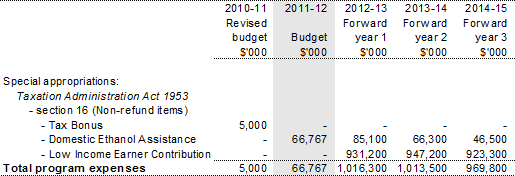
Program 1.20 deliverables
The ATO's role in delivery of the Tax Bonus involves automatically calculating eligibility and entitlement and sending payments of up to $900 to those eligible taxpayers. Successful delivery is demonstrated by:
- the dollar value of tax bonus paid; and
- the number of claims.
- ATO will be responsible for administering the domestic ethanol assistance scheme and providing compliance assurance and support. Successful delivery will be demonstrated by:
- the dollar value of claims; and
- the number of claims.
For the Low Income Earner Contribution it is intended that the ATO will be responsible for determining eligibility, calculating the amount of entitlement to be paid and making the payment, and notifying individuals of their entitlement. Successful delivery will be demonstrated by:
- the number of individuals eligible for the contribution; and
- the value of contributions distributed.
Program 1.20 key performance indicators
The ATO's role in successfully delivering this program is demonstrated by payments being made in accordance with the law.
Section 3: Explanatory tables and budgeted financial statements
Section 3 presents explanatory tables and budgeted financial statements which provide a comprehensive snapshot of agency finances for the budget year 2011-12. It explains how budget plans are incorporated into the financial statements and provides further details of the reconciliation between appropriations and program expenses, movements in administered funds, special accounts and government Indigenous expenditure.
3.1 Explanatory tables
3.1.1 Movement of administered funds between years
The ATO does not have any movement of administered funds.
3.1.2 Special accounts
Special accounts provide a means to set aside and record amounts used for specified purposes. Special accounts can be created by a Finance Minister's Determination under the Financial Management and Accountability Act 1997 or under separate enabling legislation. Table 3.1.2 shows the expected additions (receipts) and reductions (payments) for each account used by the ATO.
Table 3.1.2: Estimates of special account cash flows and balances
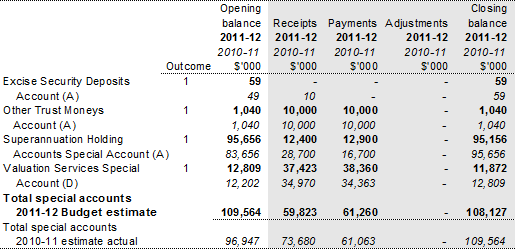
(A) = Administered.
(D) = Departmental.
3.1.3 Australian Government Indigenous Expenditure
Table 3.1.3: Australian Government Indigenous Expenditure

3.2 Budgeted financial statements
3.2.1 Differences in agency resourcing and financial statements
The ATO does not have any differences between the resource information presented in the Budget Papers and Portfolio Budget Statements.
3.2.2 Analysis of budgeted financial statements
Budgeted departmental income statement
The ATO is planning a balanced budget in 2011-12 after income tax equivalents expense from the AVO.
This excludes the impact of Operation Sunlight changes to funding whereby depreciation and amortisation expenses are not funded by appropriation from 2010-11 onward.
The budgeted departmental income statement also reflects changes arising from Budget measures as outlined in Table 2.1.
Budgeted departmental balance sheet
The ATO's assets are predominantly non-financial assets. In 2011-12, the ATO is planning a significant capital works program which will focus on:
- the development or improvement of internally developed systems and software in support of the ATO's intention of making people's experience with the revenue systems easier, cheaper and more personalised, and improving the integrity and flexibility of the superannuation business systems; and
- refreshing a number of the ATO's property holdings which are subject to lease expiry.
The ATO's liabilities continue to be predominantly employee entitlements.
3.2.3 Budgeted financial statements tables
Table 3.2.1: Budgeted departmental comprehensive income statement
(for the period ended 30 June)
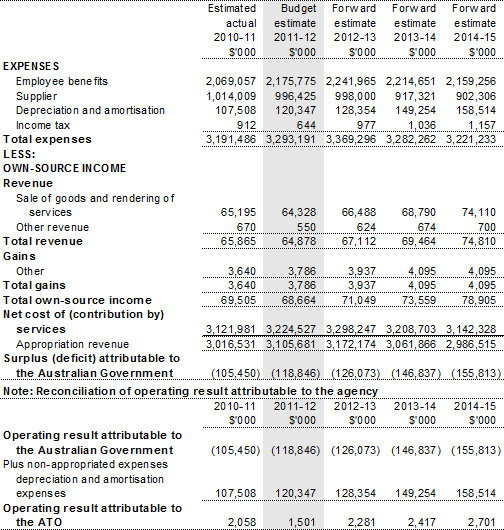
Prepared on Australian Accounting Standards basis.
Table 3.2.2: Budgeted departmental balance sheet
(as at 30 June)
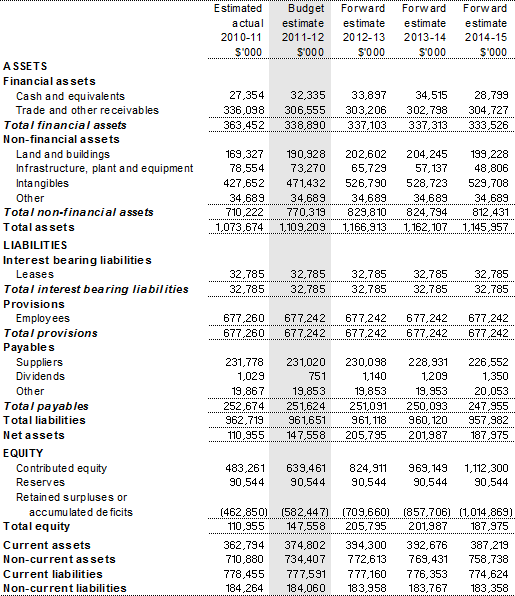
Prepared on Australian Accounting Standards basis.
Table 3.2.3: Budgeted departmental statement of cash flows
(for the period ended 30 June)
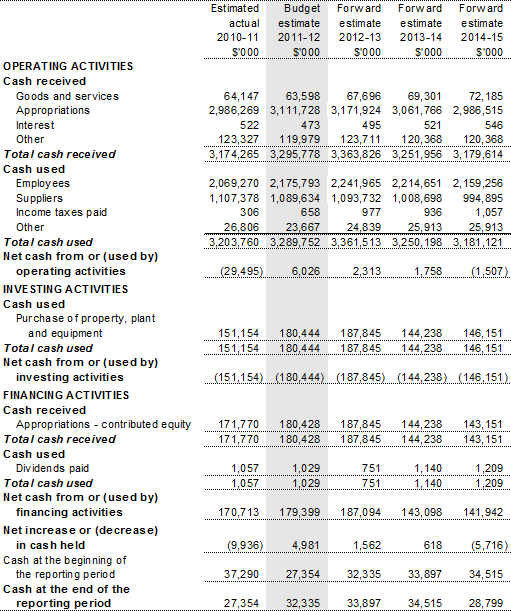
Prepared on Australian Accounting Standards basis.
Table 3.2.4: Departmental statement of changes in equity — summary of
movement (Budget year 2011-12)
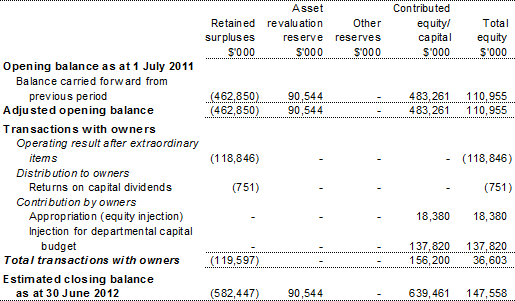
Prepared on Australian Accounting Standards basis.
Table 3.2.5: Departmental capital budget (DCB) statement
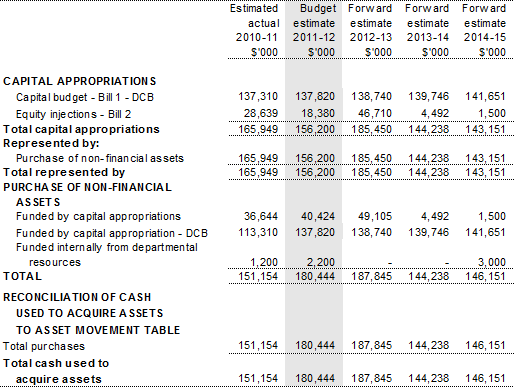
Prepared on Australian Accounting Standards basis.
Table 3.2.6: Statement of asset movements — departmental
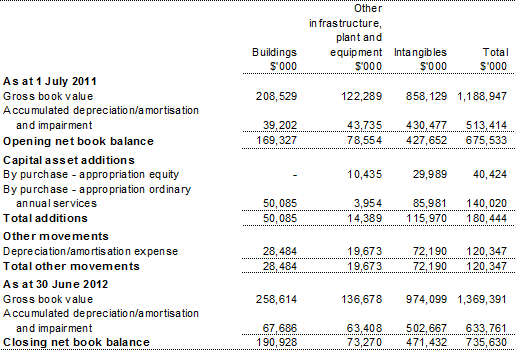
Prepared on Australian Accounting Standards basis.
Table 3.2.7: Schedule of budgeted income and expenses administered on behalf of
government (for the period ended 30 June)
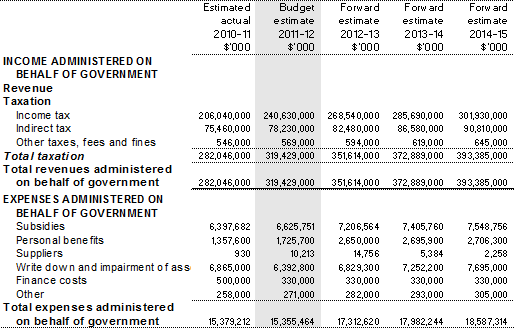
Prepared on Australian Accounting Standards basis. Also refer note in Section 3.2.4 on Recognition of taxation revenue and Items recognised as reductions to taxation revenue.
Table 3.2.8: Schedule of budgeted assets and liabilities administered on behalf of
government (as at 30 June)
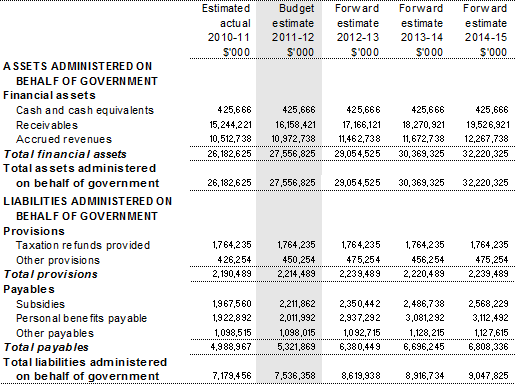
Prepared on Australian Accounting Standards basis. Also refer note in Section 3.2.4 on Recognition of taxation revenue and Items recognised as reductions to taxation revenue.
Table 3.2.9: Schedule of budgeted administered cash flows
(for the period ended 30 June)
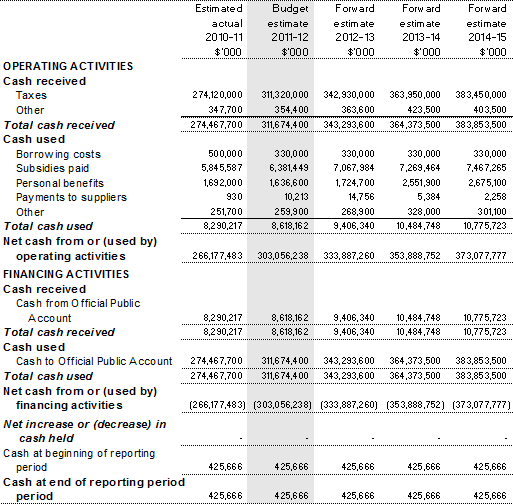
Prepared on Australian Accounting Standards basis.
Table 3.2.10: Schedule of administered capital budget
The ATO does not have any administered capital.
Table 3.2.11: Schedule of asset movements — Administered
The ATO does not have any administered non-financial assets.
3.2.4 Notes to the financial statements
Basis of accounting
The budgeted financial statements have been prepared on an accrual basis.
Notes to the departmental statements
The departmental financial statements included in Tables 3.2.1 to 3.2.6, have been prepared on the basis of Australian Accounting Standards and Department of Finance and Deregulation guidance for the preparation of financial statements.
The budget statements and estimated forward years have been prepared to reflect the following matters.
Cost of administering goods and services tax
Departmental statements include the estimated costs of administering the goods and services tax (GST) pursuant to the 'intergovernmental agreement on the reform of Commonwealth-State Financial Relations'. The GST revenue is collected on behalf of the States and Territories which agree to compensate the Australian Government for the agreed GST administration costs.
The recovery of GST administration costs are reported under the Treasury.
Notes to the administered statements
The administered financial statements included in Tables 3.2.7 to 3.2.9 have been prepared on the basis of Australian Accounting Standards and Department of Finance and Deregulation guidance for the preparation of financial statements.
The standards require that taxation revenues are recognised on an accrual basis when the following conditions apply:
- the taxpayer or the taxpayer group can be identified in a reliable manner;
- the amount of tax or other statutory charge is payable by the taxpayer or taxpayer group under legislative provisions; and
- the amount of the tax or statutory charge payable by the taxpayer or taxpayer group can be reliably measured, and it is probable that the amount will be collected.
The amount of taxation revenue recognised takes account of legislative steps, discretion to be exercised and any refunds and/or credit amendments to which the taxpayers may become entitled.
Recognition of taxation revenue
Taxation revenue is recognised when the Government, through the application of legislation by the ATO and other relevant activities, gains control over the future economic benefits that flow from taxes and other statutory charges — the Economic Transaction Method (ETM). This methodology relies on the estimation of the probable flows of taxes from transactions which have occurred in the ec
onomy, but not yet reported, and are likely to be reported, to the ATO through an assessment or disclosure.
However in circumstances when there is an 'inability to reliably measure tax revenues when the underlying transactions or events occur', the standards permit an alternative approach — the Taxation Liability Method (TLM). Under this basis, taxation revenue is recognised at the earlier of when an assessment of a tax liability is made or payment is received by the ATO. This recognition policy means that taxation revenue is generally measured at a later time than would be the case if it were measured under the ETM method.
In accordance with the above revenue recognition approach, the ATO uses ETM as the basis for revenue recognition, except for income tax for individuals, companies and superannuation funds and superannuation surcharge which are recognised on a TLM basis.
Items recognised as reductions to taxation revenue
The following items are recognised as reductions (increases) to taxation revenue and not as an expense:
- refunds of revenue; and
- increase (decrease) in movement of provision for credit amendments.